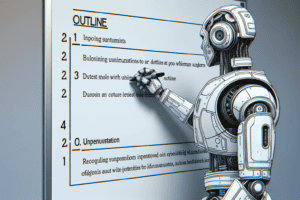The most brilliant SEO strategies can be derailed by two simple bottlenecks: content creation and Google’s ever-shifting standards.
At first glance, it would seem that AI can easily solve for the former, while adding to the risk of the latter. The power of AI to scale content creation – or at least build mediocre content for free – is well-documented by now. And everyone in SEO lives in fear of an algorithm update wreaking havoc on hard-earned results. However, AI doesn’t immediately solve SEO’s two big roadblocks. Building articles onesie-twosie with ChatGPT, Jasper, or similar tools doesn’t really solve production problems at scale.
Programmatic SEO doesn’t have to be problematic. Adding process, human editors, and QA checks to the mix helps AI content solve for both these bottlenecks.
Get With the Program(matic Content)
So we’re on the same page: “programmatic SEO” refers to the practice of publishing hundreds (or thousands, or hundreds of thousands) of pages targeting variant long tail keywords. These typically come structured in a database, and can be everything from [celebrity] + [body part] (the internet really likes feet and it’s gross) to Glassdoor’s ranking for every [job title] + salary combination. It’s particularly effective when using locations as one of the variables, in no small part because local SEO lends itself to fire-and-forget, haphazard strategies.
Programmatic SEO has a checkered past. Veterans in SEO will fondly (or not-so-fondly) remember the days of “doorway pages” designed to capture huge numbers of low volume searches and funnel them to a business’s homepage.
Now Google knows better, and is willing to say so. Unfortunately, it’s not that simple. Programmatic SEO (and corresponding content) have real use cases and can certainly qualify as “helpful” content – exactly the kind of thing Google says they don’t penalize.
Consider a business that needs location pages to help show customers where to buy their physical products. What about a services business (guitar lessons, exterminator, etc.) who wants to rank for “[business] in [suburb]” because there’s no reason you can’t serve Reseda and Northridge (or Evanston and Wilmette, Plano and Coppell, Cambridge and Somerville, etc. etc.) at the same time. A smart business will rank for “guitar lessons in Reseda” and “guitar lessons in Northridge” with different pages.
This works right up until you build content. Because it turns out those pages need basically identical content. How on earth do you vary the content enough to make these pages rank without getting in each others’ way or tanking your site? Google would encourage you to make your content more helpful by infusing more EEAT onto the page. Indeed, the least scrupulous folks working in programmatic SEO will do exactly that. They’ll add links to fake editors (who Google recognizes aren’t real entities in the space), scrape other websites to include links, quotes, and other data, and generally make asses of themselves in an attempt to fool the algorithm.
On the other end of the spectrum, you can actually build unique content for these pages. You’ll be keeping a small army of freelance writers working, and you’ll pay for it. Literally. If a freelancer is willing to work at $.25/word, and you need several hundred thousand words of content… the math is obvious.
It’s easy to see why programmatic SEO has been consigned to black hat wins followed by an endless stream of sites getting deindexed for thin content. So we return to the beginning: there’s an obvious play for SEO here, a way to support local businesses with solid strategy, but it’s completely blocked by the two most common SEO pitfalls: building good content at scale that actually deserves to rank.
Meet Your New Robot Overlords
Enter AI. AI theoretically solves these problems effortlessly. It produces cheap content with very little effort, and it builds unique content – or unique enough that Google won’t flag it.
Sure, these tools will pump out words on command, but they lack the scaling processes required to fuel a large-scale programmatic SEO strategy. Most AI tools aren’t designed to pump out unique content by the hundreds of pages; they’re designed to build one post at a time, or to build bad content at scale.
Worse, they can’t be counted on to produce accurate content. Anyone claiming you can prompt your way out of fact-checking AI content is lying. If you want anything remotely resembling EEAT, you need a real human to read, check, and edit the final product before you publish.
So to sum up: programmatic SEO should work for local SEO use cases. It should be an easy way to create large quantities of high-quality content to support SMBs across many long tail, BOFU searches and keywords. AI gets us tantalizingly close to realizing this dream, but to get across the finish line we need to apply QA, automation, and humans.
How Verblio Builds Content for Programmatic SEO
I’ll put the bottom line up front: this content works because we get humans involved with the AI early and often, tee those humans up to be as efficient as possible, and don’t as AI to do things it can’t do.
We also work with SEO clients who have their programmatic strategy in place ahead of time. We know which keywords we’re targeting, and we have key information about the business to feed into prompts for the AI. We also aren’t managing things like site design; that kind of technical SEO rests with the end client as well. Verblio’s hybrid content processes are focused on eliminating two roadblocks: efficient content production at scale that goes beyond thin content and meets quality requirements for programmatic SEO that works.
Here’s what that process looks like today:

After a setup process, we train the AI to produce web copy based on a pattern and prompt that we know will work well. Then we apply human editing, automation, and QA to make sure the content is better than the raw AI output.
Setup Matters
Getting humans involved early starts before prompting the AI. Our setup processes involve an AI expert feeding the AI examples of work – a sort of micro training model – so that the AI knows what to include or not include before we even get to prompting for individual articles. That process includes the incorporation of placeholder text. These are facts or other pieces of content we expect the AI to hallucinate or otherwise screw up. By instructing the AI to drop placeholder text in the content at these moments, we give humans a clear spot to add EEAT later while also reducing the risk the AI goes off the rails.
A common example of these placeholder tags is location. AI often writes inaccurate facts about locations, so we prompt the AI to say things like “find us [location tag] instead of “find us halfway between Mars and the asteroid belt.” Humans later update the content, replacing [location tag] with “behind Walmart on 1st St.” The content quality improves (and gets automatically fact checked) without slowing down the AI.
Prompting
Being able to prompt the AI to include the same parameters that help define the programmatic SEO strategy in the finished content is a game changer. Things we include in prompts:
- Geography
- Industry
- Product descriptions
- CTA
- Keywords
Yes, we can prompt the AI to include specific keywords in the final web copy or blog post. On the other hand, AI struggles with extensive style guide parameters or exclusive product categories. Telling the AI “write web copy for this roofing company, but don’t you dare mention that they sell window replacements, because they don’t” is a recipe for confusion. Those types of customer specifics are left out of the prompting process.
De-risking AI Content With Humans
It’s only been a few months since we were all living in fear that publishing anything written by AI would ruin a website. That ship has certainly sailed since the beginning of 2023, but at the same time the bar for content quality has gone up. Your content needs to be better than raw AI output, because anyone can just go get raw AI output (from SGE, from their own ChatGPT account, from someone else’s website). Taking the raw AI output and editing it with humans not only handles fact checking (and replacing that placeholder text), but also gives us the chance to remove risk that Google doesn’t approve of the AI output.
We de-risk AI content in four ways: working with the AI-generated outline (for blog posts), editing the final content, giving humans the option to reset the AI and insist on a total rewrite if things just aren’t good enough, and handling technical complications. Technical complications include things like formatting, internal linking, and adding real-world contact info for an SMB.
This is still, at its heart, a programmatic SEO strategy. We aren’t editing to include original research, go deep on topics only an SME could cover, or handle the vagaries of content strategy. Human editors specifically trained on AI content do things like improve sentences that sound like a precocious high schooler wrote them and make sure the AI followed a specific style guide.
QA and Automation
Once humans have successfully been added to the process, we solve for scale. We use Make, Airtable, and GPT-4 to help handle the gamut of logistical details that come with producing thousands of pieces of content:
- Project intake
- Prompt input
- Deploying pages
- Automatic delivery
- Data management
- Automated QA
- Distributing jobs to editors
- Scaling workload up and down
These are the pieces that often get left out of programmatic SEO projects, but can make or break their success. Without clean data and a clear process for moving it between tools, the AI won’t be able to deliver the content to the right person at the right time. These processes also set the human editor up to replace placeholder text, edit efficiently, and deliver the finished content on time.
Results
We’ve seen consistent results with this content. Pages aren’t getting deindexed or penalized the way most programmatic SEO is (eventually). Local SEO seems to be a sweet spot for this hybrid content designed to take the best of AI’s output and human guidance.
Our landing pages have been consistently indexed and, more importantly stay indexed. Google recognizes that this content is helpful and valuable. Rumors that the hammer would drop on any and all AI content have proven false.
Solving Impossible Problems
This is the future with AI: completing projects that weren’t feasible before. Folks often talk about AI like an intern, giving it menial tasks and watching it make you more efficient. That’s small potatoes. As AI becomes more intertwined with our work, it will unlock new projects – and tear down roadblocks.
You can borrow Verblio’s processes for derisking programmatic SEO strategies, or let us do the heavy lifting for you.



